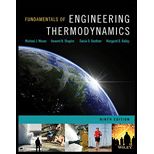
Fundamentals Of Engineering Thermodynamics, 9e
9th Edition
ISBN: 9781119391432
Author: MORAN
Publisher: WILEY
expand_more
expand_more
format_list_bulleted
Question
error_outline
This textbook solution is under construction.
Students have asked these similar questions
1) Consider the robot, with six degrees of freedom, RRPRR, shown in the following figure.Place the axes through the denavit-hartenberg algorithm and obtain the respective parameter table for the first three joints. 2) Considering the robot from question 1, calculate.the. Determine the Homogeneous Transformation Matrix in relation to the Direct Kinematics of the robot, for the first three joints:b. Considering the first three joints of the robot and L1 and L2 equal to 200 mm:I. calculate the pose of the robot relative to the base, knowing the joint variableshave the following values: q1= 90°, q2= 0°, q3= 50mm:
Please do not rely too much on chatgpt, because its answer may be wrong. Please consider it carefully and give your own answer. You can borrow ideas from gpt, but please do not believe its answer.Very very grateful!
Please do not copy other's work,i will be very very grateful!!
Don't use Artificial intelligence
Knowledge Booster
Similar questions
- Solve this problem and show all of the workarrow_forwardI need to calculate Fdy, Fby, Fbxarrow_forwardFigure 3 shows the numerical solution of the advection equation for a scalar u along x at three consecutive timesteps. 1.0- 0.8- 0.6- 0.4- 0.2 0.0- -0.2- -0.4- -0.6 T T T 3.0 3.5 4.0 4.5 5.0 5.5 6.0 6.5 Figure 3: Advection equation, solution for three different timesteps. a) Provide an explanation what conditions and numerical setup could explain the curves. Identify which of the three curves is the first, second and third timestep.arrow_forward
- please solve the following problemarrow_forwardA 5 cm external diameter, 10 m long hot water pipe at 80 degrees C is losing heat to the surrounding air at 5 degrees C by natural convestion with a heat transfer coefficient of 25 W/m^2 K. Determine the rate of heat loss from the pipe by natural convection.arrow_forwardThe outer surface of a spacecraft in space has emissivity of 0.8 and a solar absorptivity of 0.3. If solar radiation in incident on the spacecraft at a rate of 950 W/m^2, determine the surface temp of the spacecraft when the radiation emitted equals the solar energy absorbed.arrow_forward
- Of the following pairs of material types, indicate whether any of them satisfy the condition that both elements of the pair are generically related to the property of ductility.(A). Yes, ceramics and polymers.(B). No, none of the pairs.(C). Yes, metals and ceramics.(D). Yes, polymers and metals.arrow_forwardBoth Fouriers law of heat conduction and ficks law of mass diffusion can be expressed as Q=-kA(dT/dx). What do the quantities Q, k, a and T represent in a) heat conduction b)mass diffusionarrow_forward(9) Figure Q9 shows a 2 m long symmetric I beam where the upper and lower sections are 2X wide and the middle section is X wide, where X is 31 mm. The I beam sections are all Y=33 mm in depth. The beam is loaded in the middle with a load of Z=39 kN causing reaction forces at either end of the beam's supports. What is the maximum (positive) bending stress experienced in the beam in terms of mega-Pascals? State your answer to the nearest whole number. Y mm Y mm Y mm Xmm 2X mm Figure Q9 Z KN 2 marrow_forward
arrow_back_ios
SEE MORE QUESTIONS
arrow_forward_ios
Recommended textbooks for you
 Principles of Heat Transfer (Activate Learning wi...Mechanical EngineeringISBN:9781305387102Author:Kreith, Frank; Manglik, Raj M.Publisher:Cengage Learning
Principles of Heat Transfer (Activate Learning wi...Mechanical EngineeringISBN:9781305387102Author:Kreith, Frank; Manglik, Raj M.Publisher:Cengage Learning

Principles of Heat Transfer (Activate Learning wi...
Mechanical Engineering
ISBN:9781305387102
Author:Kreith, Frank; Manglik, Raj M.
Publisher:Cengage Learning